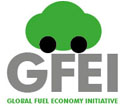
Green Tires
Tires are an often-overlooked factor in passenger vehicle energy use. According to the International Council on Clean Transportation’s research on Opportunities to Improve Tire Energy Efficiency, readily achievable improvements in tire energy efficiency could reduce global fuel consumption from passenger vehicles by as much as 5%. That would translate into a reduction in greenhouse gas emissions of more than 100 million metric tons a year. Potential annual fuel savings of 30 billion liters represent a cost savings of about US$30 billion annually if refined oil prices average US$1 per liter (or US$3.80 per gallon), thereby providing a substantial energy security benefit for oil-importing countries.
This new generation of tires is designed to help overcome rolling resistance, which occurs as tires deform during rotation. In addition, optimal tire efficiency requires proper maintenance–especially the maintenance of correct tire inflation/pressure, which greatly affects rolling resistance. To help increase consumer awareness, a number of countries (including the US, China, South Korea and Japan), have put in place tire standards, rating/labeling, and/or correct pressure programs. Proper tire inflation will improve tire durability along with efficiency and thus reduce the environmental impact of tire disposal, and potentially also reduce fine particulate emission rates.
Many of the technological improvements in "green" tires also come from the actual ingredients which go into their manufacture. Conventional tires require approximately 5-10 gallons of petroleum ingredients in the production of one single tire. Multiply this figure by the 300 million tires discarded annually in the US, and it makes for a substantial amount of petroleum products consumed by the tire industry.







